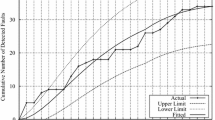Abstract
We describe software reliability growth models that yield accurate parameter estimates in spite of a small amount of input data in an actual software testing. These models are based on discrete analogs of a logistic curve model. The models are described with two difference equations, one each proposed by Morishita and Hirota. The difference equations have exact solutions. The equations tend to a differential equation on which the logistic curve model is defined when the time interval tends to zero. The exact solutions also tend to the exact solution of the differential equation when the time interval tends to zero. The discrete models conserve the characteristics of the logistic model because the difference equations have exact solutions. Therefore, the proposed models provide accurate parameter estimates, making it possible to predict in the early development phase when software can be released.
Similar content being viewed by others
References
W.D. Brooks and R.W. Montley, Analysis of discrete software reliability models. Technical Report RADC-TR-80–84, Rome Air Development Center, New York, 1980.
R. Hirota, Nonlinear partial difference equations. V. Nonlinear equations reducible to linear equations. J. Phys. Soc. Japan,46 (1979), 312–319.
A. Kanno, Software Engineering (in Japanese). JUSE Press, Tokyo, 1979.
J.-C. Laprie, K. Kanoun, C. Béounes and M. Kaâniche, The KAT (Knowledge-Action-Transformation) approach to the modeling and evaluation of reliability and availability growth. IEEE Trans. Software Engineering,17 (1991), 370–382.
M.R. Lyu, ed., Handbook of Software Reliability Engineering. McGraw-Hill, New York, 1995.
T. Mitsuhashi, A Method of Software Quality Evaluation (in Japanese). JUSE Press, Tokyo, 1981.
F. Morishita, The fitting of the logistic equation to the rate of increase of population density. Res. Popul. Ecol.,VII (1965), 52–55.
M. Ohba, S. Yamada, K. Takeda and S. Osaki, S-shaped software reliability growth curve: how good is it? Proceedings IEEE COMPSAC 82, Chicago, 1982, 38–44.
K. Ohmori and E. Shinohara, Predictive precision analysis of undiscovered errors. IEICE Tech. Rep. Switching System Engineering,98–190 (1999), 25–30.
C.V. Ramamoorthy and F.B. Bastani, Software reliability— Status and perspectives. IEEE Trans. Software Engineering,8 (1982), 354–371.
T. Sakamaki, Software reliability — Software reliability forecast for quality management. IEICE Tech. Rep. Reliability,81–8 (1981), 17–24.
K. Sakata, Formulation for predictive methods in software production control: Static prediction and failure rate transition model. IEICE Trans. Inf. & Syst.,J57 (1974), 277–283.
D. Satoh, A discrete Gompertz equation and a software reliability growth model. IEICE Trans. Inf. & Syst.,E83 (2000), 1508–1513.
D. Satoh, A discrete Bass model and its parameter estimation. J. Oper. Res. Soc. Japan,44, No. 1 (2001), 1–18.
S. Ushiki, Central difference scheme and chaos. Physica D,4 (1982), 407–424.
S. Yamada, Software Reliability Model — Fundamentals and Applications (in Japanese). JUSE Press, Tokyo, 1994.
S. Yamada, Software quality/reliability measurement and assessment: Software reliability growth models and data analysis. J. Inform. Process.,14 (1991), 254–266.
A. Iannino, J.D. Musa, K. Okumoto and B. Littlewood, Criteria for software reliability model comparisons. IEEE Trans. Software Engineering,10 (1984), 687–691.
J.D. Musa, A. Iannino and K. Okumoto, Software Reliability: Measurement, Prediction. Application. McGraw-Hill, New York, 1987.
Author information
Authors and Affiliations
Corresponding author
About this article
Cite this article
Satoh, D., Yamada, S. Parameter estimation of discrete logistic curve models for software reliability assessment. Japan J. Indust. Appl. Math. 19, 39–53 (2002). https://doi.org/10.1007/BF03167447
Received:
Revised:
Issue Date:
DOI: https://doi.org/10.1007/BF03167447




